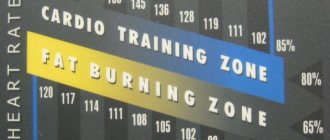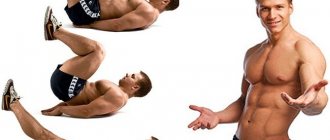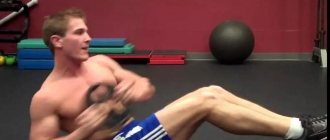We have already proven in many articles that abs will appear on your stomach only after you get rid of excess weight on your stomach. And the most effective method for this is cardio training. They are not only effective in burning belly fat, but also for losing weight throughout the body.
As you know, cardio training is the best assistant in losing weight. Any fat-burning diet recommends regular cardio training, since such training actively trains the heart and helps burn excess fat deposits. Let's look at the 7 best cardio workouts for weight loss every day.
Run
Of course, running is the best and necessary cardio workout for weight loss. You can run in the gym on a treadmill, and in the warmer months in the park or around the house. In order to burn fat by running, you need to jog in the morning, before breakfast, or in the evening, after strength training. This kind of cardio is best done on an empty stomach, that is, do not eat anything 2-3 hours before the planned workout. A running workout should last about 30-60 minutes. For running, carefully choose shoes, preferably special running shoes with thick soles, so as not to damage your knees and joints.
What exercises are best for weight loss?
There is no best type of cardio for weight loss. If you enjoy visiting fitness centers to burn off extra calories, keep doing it. If you prefer to be outdoors, always do your cardio outside. The most important thing in any case is to stick to a clearly defined training plan and do the exercises that you like.
It's worth noting that you will likely want to avoid performing exercises on a specific body part if you are doing strength training on that very body part. For example, if you do cardio in the morning and lift legs in the evening, it's best to do upper-body cardio exercises (such as rope or hammer exercises). In the same way, you can do strength training in the morning after cardio, and continue strength training in the evening to quickly build muscle mass while dieting.
Step aerobics
To carry out this workout, you will need a special step platform. Step aerobics involves active exercises similar to dancing. So, in one such workout you will burn no less calories than in an hour of running. You can do step aerobics in special classes, or you can do it at home, via video, that is, in principle, no special conditions are required. This cardio workout can be done at home.
How much effort should you put into cardio exercises?
Many people who exercise on their own prefer low-intensity cardio exercises to maintain their heart rate. While this type of exercise does burn more calories, there is not much difference in the number of calories burned over a 24-hour period between low-intensity and high-intensity exercise. That is, supporting cardiac ri during low-intensity exercise does not lead to improved results. Additionally, a recent meta-analysis of cardiovascular exercise found that low-intensity exercise had a negative effect on muscle mass and strength gains compared to high-intensity exercise. Based on these results, high-intensity cardio is the optimal approach. However, it is worth noting that high-intensity cardio exercises have a high risk of injury, and can also take a toll on the body during strength training and weightlifting. Thus, the exerciser will want to reduce the amount of time allocated to cardio. All things considered, it's best to do high-intensity exercise whenever possible. But if you also do powerlifting or other strength training, low-intensity cardio may be better for you.
Jumping
Jumping helps actively burn excess fat deposits and also trains the leg muscles. Jumping is a fairly easy way to lose weight and a great cardio workout at home, at a time convenient for you. When starting training, do not jump for 30-60 minutes a day right away. Start with short workouts of 10 minutes. Then, after a couple of weeks, you will be able to jump more, while using different jumping methods. For this workout you will need good shoes, preferably running ones, so that you don't hurt your knees.
Which cardio is best for cutting, burning fat and losing weight?
Which cardio is best for cutting, burning fat and losing weight? Find out the fastest way to lose weight without harming your health and without wasting muscle mass.
Which cardio is best for cutting, burning fat and losing weight?
Many gym goers come there to burn fat. To do this, they perform cardio exercise, as this allows them to increase calorie expenditure.
We'll try to answer the most common questions about cardio using scientific research.
How much cardio should you do?
A recent meta-analysis (statistical analysis of multiple studies on the same topic) on cardio found that gains in muscle mass and strength decreased as cardio volume increased. Therefore, it is better to limit yourself to a small amount of cardio.
However, the absence of cardio exercise during the “drying” period is not entirely correct. How much cardio should you do to enhance fat burning, but not negatively affect muscle size and strength? Let's first deal with such a thing as energy balance.
You gain weight when your energy intake exceeds your energy expenditure—this is the basis of a muscle-building diet. When you lose weight, the opposite happens.
You need to create an energy deficit by reducing calorie intake and increasing physical activity.
If you only reduce the number of calories you consume, then the energy deficit will not be significant. However, adding cardio will increase it.
Therefore, the optimal amount of cardio is just enough to burn the number of calories you need to achieve a noticeable deficit.
What kind of cardio should you do to burn fat?
It is impossible to say for sure that any type of cardio is better for weight loss. This could be group classes in the gym or jogging in the fresh air. You just need to be consistent and do what you like.
One subtlety - you should do cardio without harming the target muscle group. For example, if you do cardio in the morning and train your legs in the evening, it is better to opt for a cardio exercise that primarily uses the torso muscles (rope rotations or tire hammer hits).
How intense should your cardio workout be?
It is believed that cardio should be low intensity to maintain your heart rate in the fat burning zone. However, research shows that when you do high-intensity cardio or cardio in the fat-burning zone every day, you burn fat just as quickly.
Additionally, a meta-analysis found that low-intensity cardio was worse for muscle mass and strength than high-intensity cardio. Based on these data, we can conclude that high-intensity cardio is better for fat loss.
However, it should be noted that it is more difficult to recover from, you can get injured while doing it, and training with iron will be less productive if you do not have time to recover from cardio. Joint problems may also occur.
If you have the opportunity, it is better to do high-intensity cardio. But if you have problems with recovery and performance in the gym, you can do less intense forms of cardio.
Should you do cardio in the morning on an empty stomach?
Many people do cardio in the morning on an empty stomach because they think it will burn more fat. However, no objective data confirms this.
Research shows that cardio burns the same amount of calories on a full and empty stomach. However, if you look at what happens to the body after a workout, more fat is burned after cardio NOT on an empty stomach.
In addition, during cardio on an empty stomach, many amino acids are consumed and protein breakdown occurs in the muscles. This should not happen if your goal is to maintain muscle while losing weight.
Useful article: “The 5 Best High-Intensity Interval Training for Fast Weight Loss”
In one recent study, young men with the same diet and calorie deficit did an hour of cardio in the morning three times a week for one month. Half of the study participants drank a protein shake before cardio, while others drank a protein shake after cardio. After one month, there was no significant difference in body fat, muscle, or weight loss between participants in either group.
Therefore, there is no significant difference whether you eat something before cardio training or not. However, if you do do cardio on an empty stomach, you should drink a serving of protein before or after your workout to prevent muscle loss.
Results:
- There is no best type of cardio for burning fat. Do what you enjoy and don't be afraid to add variety to the process.
- Do only as much cardio as you need for sustainable weight loss.
- Do high-intensity cardio whenever possible. If it interferes with strength training, replace it with a less intense form.
- Do cardio on an empty stomach or after a meal, as per your preference. When doing cardio on an empty stomach, drink a protein shake after your workout.
Abs and cardio: example of building a workout
The most productive cardio for getting rid of fat deposits is interval training. If you are a beginner, then the maximum result for you is real with classes of 40-50 minutes. However, first you need 5 minutes. devote time to warm-up. Next comes a stage of moderate-intensity work lasting approximately 4 minutes. and 1 min. high intensity training. Train in this mode for 30 minutes, then be sure to do some stretching (10 minutes).
If you exercise occasionally, then your morning cardio workout for weight loss is a more intense option. Reduce the time of moderate and high-intensity exercise by half. The total duration of the training should be no more than 30 minutes. This rhythmic training has a positive effect on metabolism compared to long-term training.
There are various types of cardio, from which choose the most attractive for yourself.
Active walking also helps burn calories. Move your arms intensively, walk for about 1 hour a day, and literally in a month you will notice a toned body.
One of the best cardio options is pool workouts. By exercising in the pool, you will strengthen your leg muscles and your stomach will become noticeably toned.
Running is the most accessible and one of the most effective types of physical activity. It is useful to run in the fresh air, and you can also do it on a treadmill for 30-60 minutes. And to get the desired effect, it is better to train on an empty stomach.
Cycling also helps burn calories. If you don't have problems with your knees, then this is a good type of exercise.
Try step aerobics. During an intense workout, you will burn off as many calories as running for an hour.
Another popular form of cardio is boxing. During the classes, the leg muscles are involved, the heart muscle is stressed, and coordination of movements is noticeably improved.
Cardio classes are available at home. What will you need? Just a jump rope, comfortable sneakers and clothes. From the very first training, you should not exhaust yourself with heavy exercises. Start with 10-15 min. per day, and then gradually, increasing the load.
When to put cardio before strength training?
The body's aerobic capacity is much greater when aerobic training is done early on.
This fact was confirmed by a 2005 study (link). It compared two groups of subjects. One did circuit training and then did a 4km running test. The other trained in the reverse order.
The study found that cardio training over strength training provided an advantage in the form of an increase in the Aerobic Capacity parameter , which gave the subjects a chance to pass the running test more successfully.
Aerobic Capacity is the maximum amount of oxygen the body can use during exercise. Directly depends on the capabilities of the cardiovascular and respiratory systems. Their functions improve with training.
Another study (link) found a different pattern. If you do strength training before cardio, during cardio your heart rate can increase by an average of 12 beats per minute . This can make the load seem more intense than it is. Also, a high heart rate will make you feel tired much earlier and stop training.
Finally, another study (link) found that even a single strength training session can reduce the effectiveness of cardio due to 4 factors, including depletion of muscle glycogen stores and muscle pain .











